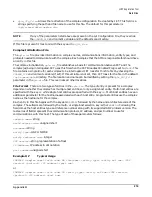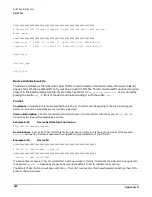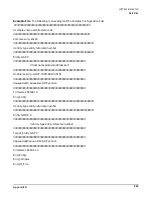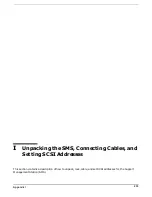
Appendix H
JUST Exploration Tool
Data Files
227
Example H-17
Default ID
##################################################################
# Default_Id <device name> <default jtag id string>
##################################################################
Default_Idpcxx0x3AA2-1006
End of File Marker This file must end with the keyword
End_Of_File
.
Link Architecture File
The link architecture file describes the possible link interconnects possible within a complex. These
connections are any that are not static within a system.
There is only one link architecture file for each complex and it must be named
link.arc
.
Output Data Files
JET produces both data files and log files. Other scan tools use the data files created by JET as input
information. The log file generated by JET contains information on its execution. JET output files are
described in the following sections.
Complex Configuration File
This file contains information on the systems available for test on a particular network. It is used by the
Libsdp
library to direct messages from the test station to the system under test.
There is only one complex configuration file, which must be named
complex.cfg
. It may contain entries for
multiple complexes. JET places this file in the default scan directory
/opt/scansw/data
.
System entities represent MPs and nodes. The data contained in this file provides information on what
entities can be tested and the basics of how to communicate with each of the entities specified. This file is
normally created by JET. Below is a description of each entry in the file.
Comments Comments in this file are specified by placing a # character at the beginning of the line
containing the comment. End of line comments are not currently supported.
Complex Entries Each complex entry in the file begins with the keyword
Complex
followed by the complex
name string and the complex’s architecture code. A complex entry ends with the keyword
End_Complex
. Both
of these entries must be on separate own lines.
Example H-18
Complex Entries
Complex <complex name> <architecture code>
.
.
.
End_Complex
Between these tags are the entity instances described below.
Entity Entries Entities exist within the complex tags. There are currently of two types: GSP or NODE. Each entity
begins with the keyword
Entity
, followed by the entity type and its reference number, and ends with the keyword
End_Entity
. Each of these tags must be on a separate line as shown below:
Содержание 9000 Superdome
Страница 8: ...Contents 8 ...
Страница 9: ...9 Preface ...
Страница 21: ...21 IEC 60417 IEC 335 1 ISO 3864 IEC 617 2 International Symbols ...
Страница 22: ...22 Figure 9 Superdome Declaration of Conformity Page 1 ...
Страница 23: ...23 Figure 10 Superdome Declaration of Conformity Page 2 ...
Страница 24: ...24 ...
Страница 32: ...Chapter 1 Introduction Installation Warranty 8 ...
Страница 130: ...Chapter 4 Verifying and Booting Superdome Enabling iCOD 106 ...
Страница 146: ...Chapter 6 Troubleshooting and Installation Related Tasks Installing a PCI I O Card While the Cell is Off 122 ...
Страница 154: ...Chapter 7 No Boot Disk Superdome Installations Installing the Superdome Operating System From Available Media 130 ...
Страница 172: ...Appendix A hp Server rx2600 Support Management Station Configuring the SMS 148 ...
Страница 184: ...Appendix C Superdome LAN Interconnect Diagram 160 ...
Страница 193: ...Appendix F 169 F A180 Support Management Station ...
Страница 230: ...Appendix G Connecting Multiple SPU Cabinets Connecting Cables 206 ...
Страница 256: ...Appendix H JUST Exploration Tool Error Conditions 232 ...








































